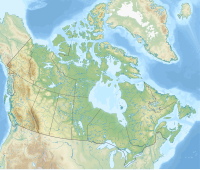Mount Daly (Waputik Range)
Appearance
| Mount Daly | |
|---|---|
 Mount Daly and Bath Glacier | |
| Highest point | |
| Elevation | 3,148 m (10,328 ft)[1] |
| Prominence | 368 m (1,207 ft)[1] |
| Parent peak | Mount Balfour (3,272 m)[1] |
| Listing | Mountains of Alberta Mountains of British Columbia |
| Coordinates | 51°31′07″N 116°23′44″W / 51.51861°N 116.39556°W[2] |
| Geography | |
| Country | Canada |
| Provinces | Alberta and British Columbia |
| Parent range | Park Ranges |
| Topo map | NTS 82N9 Hector Lake[2] |
| Climbing | |
| First ascent | 1903 J.H Batcheller, C.E. Fay, E. Tewes, C. Bohren, C. Hasler Sr.[3][1] |
Mount Daly is located on the border of Alberta and British Columbia. It was named in 1898 by Charles E. Fay after Charles P. Daly, a geographer.[3][1][4] Mount Niles is located two km southwest of Daly.
Geology
[edit]Like other mountains in Banff Park, Mount Daly is composed of sedimentary rock laid down during the Precambrian to Jurassic periods.[5] Formed in shallow seas, this sedimentary rock was pushed east and over the top of younger rock during the Laramide orogeny.[6]
Climate
[edit]Based on the Köppen climate classification, Mount Daly is located in a subarctic climate with cold, snowy winters, and mild summers.[7] Temperatures can drop below -20 °C with wind chill factors below -30 °C.
See also
[edit]References
[edit]- ^ a b c d e "Mount Daly". Bivouac.com. Retrieved 2019-09-16.
- ^ a b "Mount Daly (BC)". Geographical Names Data Base. Natural Resources Canada. Retrieved 2019-09-16.
- ^ a b "Mount Daly". cdnrockiesdatabases.ca. Retrieved 2019-09-16.
- ^ Place-names of Alberta. Ottawa: Geographic Board of Canada. 1928. p. 41.
- ^ Belyea, Helen R. (1960). The Story of the Mountains in Banff National Park (PDF). parkscanadahistory.com (Report). Ottawa: Geological Survey of Canada. Archived (PDF) from the original on 2015-10-02. Retrieved 2019-09-13.
- ^ Gadd, Ben (2008). Geology of the Rocky Mountains and Columbias.
- ^ Peel, M. C.; Finlayson, B. L.; McMahon, T. A. (2007). "Updated world map of the Köppen−Geiger climate classification". Hydrol. Earth Syst. Sci. 11: 1633–1644. ISSN 1027-5606.



